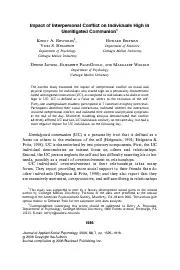

Participantswerefortyoneundergraduatestudents12male29femaleThesestudentsweredrawnfromagroupof133individualswhowereparticipatinginastudyonadjustmenttocollegeUCscoreswerecalculatedforeachindividua ID: 206750
Download Pdf The PPT/PDF document "(Fritz&Helgeson,1998).Additionally,UCisa..." is the property of its rightful owner. Permission is granted to download and print the materials on this web site for personal, non-commercial use only, and to display it on your personal computer provided you do not modify the materials and that you retain all copyright notices contained in the materials. By downloading content from our website, you accept the terms of this agreement.
(Fritz&Helgeson,1998).Additionally,UCisassociatedwithruminatingaboutothersproblems.TwostudiesbyFritzandHelgeson(1998)foundthatindividualswhoscoredhighinUCreportedmoreintrusivethoughtsthandidotherindividuals2daysaftertheywereexposedtoaproblemthatwasdisclosedbyafriendinonestudyandastrangerinanotherstudy.UCindividualsmaybecomeoverinvolvedintheirrelationshipsbecausetheyderivetheirself-esteemfromothersopinionsofthem.UChasbeenassociatedwithanexternalizedself-perception(Fritz&Helgeson,1998),whichmeansthattheybasetheirviewsofthemselvesonhowtheyareperceivedbyothers.Thisisespeciallytroublesomebecausetheybelievethatothersviewthemnegatively.Anexternalizedself-perceptionandanegativeperceivedregardbyothersarelinkedtothelowself-esteemofUCindivid-uals(Fritz&Helgeson,1998).Providinghelptoothersmaybeanattempttoenhancetheirworthintheeyesofothers(Helgeson&Fritz,1998).Overinvolvementinrelationshipsmayleadtodistress.IndividualswhoscorehighinUCreporthigherlevelsofanxietyanddepressioninbothcross-sectional(Fritz&Helgeson,1998)andlongitudinalstudies(Fritz,2000,Helgeson,1993;Helgeson&Fritz,1996).Thereissomeevidencethathighlevelsofdistressarearesultofoverinvolvementinrelationships.Across-sectionalstudyfoundthatoverinvolvementinrelationshipsmedi-atedtherelationofUCtodepression(Fritz&Helgeson,1998).Alongi-tudinalstudyofadolescentswithdiabetesfoundthattheintensityofrelationshipstressorsmediatedtherelationofUCtoincreasesinpsycho-logicaldistressovertime(Helgeson&Fritz,1996).UCindividualsalsoneglecttheself.UCisassociatedwithhavingdif-ficultydisclosinginformationabouttheselftoothers,feelinguncomfortablereceivingsupportfromothers,andhavingdifficultyassertingonesneeds(Fritz&Helgeson,1998).Thisself-neglectcanhavephysicalhealthconsequences.UChasbeenassociatedwithpoorcompliancewithhealthregimensandpoorhealthbehavior(Helgeson,1993,2003;Helgeson&Fritz,2000).AstudyofadolescentswithdiabetesalsodemonstratedthatUCwasassociatedwithpoormetaboliccontrolandpredicteddeteriorationinmet-aboliccontrolovertime,possiblyasaresultofpoorself-carebehavior(Helgeson&Fritz,1996).AllofthepreviousworkexamininghowUCpeoplebehaveinre-lationshipshasreliedonindividualsretrospectivereportsoftheirusualbehavior.Asistypicalinmostcorrelationalstudies,participantsareaskedtodescribehowtheyusuallybehaveorhowtheyhavebehavedoverthepastseveralweeks.Therearelimitationstotheaccuracyoftheseretrospectivereports.Inthecurrentstudy,wewanttoexaminemoreproximalreportsofrelationshipbehaviorforpeoplewhowerehighinUC.Tothisend,weREYNOLDSETAL. Participantswereforty-oneundergraduatestudents(12male,29female).Thesestudentsweredrawnfromagroupof133individualswhowereparticipatinginastudyonadjustmenttocollege.UCscoreswerecalculatedforeachindividualinthelargerstudy,andthesescoresweredividedintotertiles.BecausethepurposeofthepresentstudyistocompareindividualshighinUCtootherindividuals,weoversampledthetoptertileofscores.Werandomlyselectedandinvitedstudentsfromtheupperthird(UCgroup)andbottomtwothirds(non-UCgroup)toparticipateinthestudyuntilwehadachievedsufficientsamplesizesforeachofthetwogroups.Weinvited33peoplefromeachgrouptoparticipate,withtheresultthat21fromthetopthird(63.6%)and20fromtheothertwothirds(60.6%)Onthe5-pointunmitigatedcommunionscale,themeanfortheUCgroupwas3.95,andthemeanforthenon-UCgroupwas2.57.MalesandfemalesweredistributedevenlybetweentheUCgroupandthenon-UCTrainingsession.Participantscameintothelaboratoryforagrouporientationandtrainingsessionthatlastedapproximately1hr.First,weexplainedthebroadgoalsandgeneralprocedureforthestudy.Weex-plainedthatparticipantswouldbeinterviewedbytelephoneonsevencon-secutiveevenings.Astheinterviewsfocusedonsocialinteractionsandconflict,wedefinedthesetermsfortheparticipants.Socialinteractionsweredefinedasaperiodof10minutesorlongerinwhichyouandanotherpersonarerespondingtooneanother,whichisconsistentwithBrissetteandCohen(2002).Examplesofsituationsthatwereregardedassocialinteractionsincludedchattingwithafriend,havingareal-timeonlineconversationwithsomeone,ortalkingtosomeoneonthephone.Examplesofsituationsthatwerenotconsideredsocialinteractionsincludesilentlystudyinginaroomwithanotherperson,listeningtoaclasslecture,orreadinge-mailfromafriend.Wedefinedconflictasanytensionordisagreement,whichneednotbeexpressed.Wealsoinformedparticipantsthatwewouldaskthemafewbriefquestionsaboutconflictinteractionsthatwerelessthan10mininlength.Thisisnotaprocedurethathasbeenemployedinpreviousresearch.REYNOLDSETAL. Unmitigatedcommunion.Thenine-itemUCscaleassessestheextenttowhichanindividualreportsfocusingonotherstotheexclusionoftheself(Helgeson&Fritz,1998).SampleitemsincludeIalwaysplacetheneedsofothersabovemyownandEvenwhenexhausted,Iwillalwayshelpotherpeople.Participantsrateditemsonascalerangingfrom1(stronglydis-)to5(stronglyagree).Thealphaforthisscalewas.75.Interactionquestionnaire.Informationcollectedaboutsocialinteractionsincludeddurationoftheinteractionandwhoparticipatedintheinteraction.Participantsalsoreportedwhetherornottherewastensionordisagreement(conflict)duringtheinteraction.Iftherewasconflict,participantsindicatedwhetherornotthesituationwasresolved().Participantsratedtheirmoodfollowingbothconflictandnon-conflictinteractionsonscalesrangingfrom1(veryunhappy)to5(veryhappy)andfromveryanxious)to5(verycalm).Wereverse-scoredtheseitemssothathighernumbersrepresentmoredepressedmoodandmoreanxiety,respec-tively.Participantsalsoratedhowtheyfeltaboutthemselvesaftertheinteractiononascalerangingfrom1(feltverybadaboutself)to5feltverygoodaboutself).Forbriefinteractions(lessthan10min)thatinvolvedconflict,weonlyaskedwhethertheconflictwasresolvedEnd-of-dayquestionnaire.Weassesseddailyanxiety,depressedmood,andself-esteembyhavingparticipantsratetheextenttowhichseveraladjectivesdescribedtheirfeelingsoverthecourseoftheday.Eachadjectivewasratedonascalerangingfrom1(notatall)to5(alot).Tomeasureanxiety,weaskedparticipantstoratetheextenttowhichtheyfelttense,calm(reverse-scored),andanxious.Thealphasforthisscalewere.84forDay1and.90whentheitemswereaveragedacrossthe7days.Tomeasuredepressedmood,weaskedparticipantstoratetheextenttowhichtheyfeltsad,depressed,andhappy(reverse-scored).Thealphasforthescalewere.83forDay1and.90whentheitemswereaveragedacrossthe7days.Tomeasureself-esteem,weaskedparticipantstoratetheextenttowhichtheyfeltsatisfiedwiththemselves.Wealsoassessedparticipantsphysicalsymptoms.Weaskedparticipantstoidentifyphysicalsymptomstheyhadexperiencedthroughoutthedaybyindicatingwhethertheyhadexperiencedanyofthefollowing:headache,nauseaorupsetstomach,coldsymptoms,achesandpains,andlowenergy.Thisscaleisasummarymeasureofphysicalsymptomsthatcapturesavarietyofmildailments.Becausewedonotexpectallphysicalsymptomstooccursimultaneously,itisnotusefultocalculateinternalconsistencyoftheREYNOLDSETAL. interactionusingathree-levelmodel(socialinteractionsnestedwithindays;daysnestedwithinparticipant).Wedidnotexaminetheprospectiverelationbetweenconflictinonesocialinteractionandoutcomesinthefollowingsocialinteractionforanumberofreasons.First,thenumberofsocialinteractionsandthelengthoftimebetweensocialinteractionsvariedgreatlybetweendaysandbetweenpeople.Intheprospectivedayanalyses,eachparticipanthadthesamenumberofobservations(7days),andthelengthoftimebetweenobserva-tionswasuniform(1daybetweenobservations).Additionally,informationspecifictosocialinteractionswasrecalledretrospectivelyattheendoftheday,meaningthatanalysesexaminingtherelationbetweenonesocialin-teractionandthenextinteractionwouldnotbetrulyprospective.Forallofouranalyses,weusedSASProcMixed.Thebasicformulasforthemodels,andthespecificationsthatweusedarepresentedforeachtypeofanalysis.Within-dayanalyses.Thewithin-dayanalysesexaminetherelationbe-tweenconflictandoutcomesonthesameday.Becauseweareinterestedindeterminingindividualsreactivitytoconflict,weusedperson-centeredcon-thatis,theamountthatanindividualdeviatesfromhisorhernormallevelofconflictasourpredictorvariable.Person-centeredconflictiscalculatedbysubtractingtheaveragenumberofdailyconflictsfromthenumberofconflictsapersonencounteredonagivenday.Thisproducessevenscoresthatindicatehowmuchconflictdeviatedfromnormaloneachday,withhigherscoresindicatingmoreconflictthanusual.Amaineffectforperson-centeredconflictwouldindicatethatmoodorsymptomschangewhenindividualshavemoreorlessconflictthanusual.Forourpurposes,itismoreappropriatetouseperson-centeredconflictthanthenumberofconflictsexperiencedinagivendaybecauseindividualsdifferintheirav-eragenumberofconflicts.Therelationbetweenthenumberofconflictsandoutcomeswouldmainlydemonstratedifferencesbetweenconflict-proneindividualsandotherindividuals.Themodelusedtoexaminetherelationbetweenperson-centeredconflictandoutcomesonthesamedayisasfollows:whereOistheoutcomeattheendoftheday(physicalsymptoms,anxiety,depressedmood,orself-esteem),Cistheperson-centeredconflictscoreforeachday,andUistheindividualsUCgrouping(UCgroupornon-UCgroup).UrepresentstheinteractionbetweenUCgroupingandconflict,andrepresentserror.Thecoefficientbistheregressioninter-cept,andthecoefficientsbthroughbaretheeffectsoftheindependentvariables.Becauseparticipantsvaryintheirbaselinereportsofoutcomes,REYNOLDSETAL. forparticipantandarepeated-measureseffectforday,accountingforautoregressiveresidualsassociatedwithrepeateddaysbysettingthetypetoar(1).Likethefirstmodel,wereportMLestimation.However,wedidtestbothMLandREML,andtheresultsforthetwomodelswerehighlysimilar.Within-interactionanalyses.Thewithin-interactionanalysesexaminetherelationbetweenconflictinasocialinteractionandmoodreportedforthatinteraction.Themodelisasfollows:whereMisthemoodassociatedwithasocialinteraction(anxiety,depressedmood,orself-esteem),Ciswhetherornotaconflictoccurredduringtheinteraction(YesorNo),andUistheindividualsUCgrouping(UCgroupornon-UCgroup).U;representstheinteractionbetweenUCgroupingandconflict,andrepresentserror.Inthismodel,weincludedarandomeffectforparticipantandarandomeffectforday.Wealsoincludedarepeated-measureseffectforsocialinteractionthataccountedforautore-gressivetendenciesbetweentheresidualsofsocialinteractionsthataretemporallyclosetooneanotherbysettingthetypetoar(1).Overall,participantsaveragedapproximately5.15socialinteractionsperday(2.71)andspentanaverageof5.67hours(4.34)inthoseinteractions.Neitherthenumberofsocialinteractionsreportednorthedurationofinteractionschangedoverthecourseofthe7daysofinterviews.Participantsreportedanaverageof0.86conflictsperday(approximatelytwothirdsofwhichwerereportedasresolved.Approx-imately20%ofthereportedconflictswerebrief(i.e.,lastinglessthan10min).TherewerenodifferencesbetweentheUCandnon-UCgroupsonanyofthesocialinteractionvariables.TheUCandnon-UCgroupsalsodidnotdifferinmeanlevelsofphysicalsymptoms(1.22),anxiety2.51),ordepressedmood(1.90)reportedattheendoftheday.Thetwogroupsdidreportdifferentlevelsofself-esteemattheendoftheday,withtheUCgroupreportinghigherlevelsofself-esteem(thanthenon-UCgroup(Within-dayanalyses.Theresultsofthemultilevelmodeltestingthere-lationbetweenperson-centeredconflictandoutcomesonthesamedayre-vealmaineffectsofconflictonphysicalsymptoms,(1,244)(1,244).01;anddepressedmood,(1,244).01,suchthatexperiencingmoreconflictthanusualonagivendaywasREYNOLDSETAL. Theinteractionsforanxietyanddepressedmoodshowasimilarpattern(seeFigures3and4).AsconflictonDaynincreases,theUCgroupshowsmoredistress,whilethenon-UCgroupshowslessdistress.Forself-esteem(seeFigure5),whichisapositiveoutcome,theUCgroupshowsafairly low (-1)high (+1) Non-UC group Figure3.Theinteractionoftheunmitigatedcommuniongroupandperson-centeredconflict(Dayn)onanxietyforDayn low (-1)high (+1) y Depressed Mood Non-UC group UC group Figure4.Theinteractionoftheunmitigatedcommuniongroupandperson-centeredconflict(Dayn)ondepressedmoodforDaynREYNOLDSETAL. significantdifferencesbetweenthem.Therehasbeenlittleworkaddressingcomparisonsofmultivariateoutcomesinthecontextofmultilevelmodels,andthereiscurrentlynosupportforthistypeofanalysisinanystandardsoftwarepackages.Theside-by-sideplotshelptoillustratewhetherourin-terpretationoftheinteractionsisaccurate.Figure6showsthatphysicalsymptomsdeclinedbetweenDaynandDayn1forthenon-UCgroupwhenconflictonDaynwashigh,whereasphysicalsymptomsdidnotde-clinebetweenDaynandDayn1fortheUCgroupwhenconflictonDaynwashigh.Wewereabletoconductcontrastsaspartoftheleast-squaresmeanstesttodeterminesignificantdifferencesbetweenUCandnon-UCgroupsonlow-andhigh-conflictdays.BoththeUCgroupandthenon-UCgroupreportedmorephysicalsymptomsondayswithhighlevelsofconflictascomparedtodayswithlowlevelsofconflict,(1,175).01;and(1,175).05,forhighandlowlevelsofconflict,respectively.Contrastsindicatethattherewasnodifferenceinphysicalsymptomsbe-tweentheUCandnon-UCgroupsonDaynwhenconflictwasloworwhenconflictwashigh.However,onthefollowingday(Dayn1),theUCgroupreportedmorephysicalsymptomsthandidthenon-UCgroupwhentherewasahighlevelofconflictonDayn,(1,175)buttherewasnodifferencebetweentheUCandnon-UCgroupswhentherewasalowlevelofconflictonDayn.OnDayn1,theUCgroupreportedmorephysicalsymptomsfollowinghighratherthanlowconflict,.01,whereastherewasatrendforthenon-UCgrouptoreportfewerphysicalsymptomsfollowinghigh-ratherthanlow-conflict Day nDay n+1Day nDay n+1Day nDay n+1Day nDay n+1 low conflicthigh conflictlow conflicthigh conflict Non-UCUC Figure6.MeanphysicalsymptomsonDaynandDayn1asafunctionofhigh-orlow-conflictandunmitigatedcommuniongroup.REYNOLDSETAL. .08;andanxiety,(1,1195).07,suchthattheUCgroupreportedlessanxietyandlessdepressedmoodaftersocialinteractionsingeneralthandidthenon-UCgroup.TherewasalsoaninteractionbetweenconflictandUCgroupondepressedmood,(1,1197).05.TheUCandnon-UCgroupsexperiencedsimilarlevelsofdepressedmoodfol-lowingconflictinteractions,buttheUCgroupexperiencedlessdepressedmood(greaterhappiness)thandidnon-UCindividualsfollowingnon-con-flictinteractions(seeFigure7).Inthepresentpaper,weaddressedthreemainquestionsaboutconflictinindividualsdailysocialinteractions.First,isconflictassociatedwithphys-icalsymptomsanddistressonadailybasisforallpeople?;second,aretheserelationsstrongerforUCindividualsthanfornon-UCindividuals?;andthird,doesconflicthaveamoreenduringimpactonUCindividuals,ascomparedtonon-UCindividuals?Asanticipated,conflictwasassociatedwithincreasedend-of-dayanxiety,depressedmood,andphysicalsymptomsforallpeopleinoursample.Itwasnotassociatedwithpoorself-esteemattheendoftheday.WedidnotfinddifferencesintheimpactofconflictonmoodorphysicalsymptomsattheendofthedaybetweenUCandnon-UC noyes Non-UC group UC group Figure7.Interactionofunmitigatedcommuniongroupandconflictondepressedmoodattheendofasocialinteraction.REYNOLDSETAL. theirfriendsfeelingsofillwill,astheyderivetheirsenseofselffromothersopinionsofthem.ThisinternalizationmaycausethenegativeeffectofconflicttospilloverintothefollowingdayastheUCindividualcontinuestothinkabouthisorhertransgression.Non-UCin-dividualsarelesslikelytointernalizetheirfriendsnegativefeelings,thustheirmoodwouldimproveaftertheinitialunpleasantnessoftheconflicthadpassed.ItisalsopossiblethatUCindividualsaremorelikelythannon-UCindividualstoviewconflictasathreattotherelationshipscontinuedex-istence.Becausetheyhighlyvaluerelationships,thismaymaketheconflictmoreaversive,causingprolongeddistressandphysicalsymptoms.Fornon-UCindividuals,conflictislesslikelytobeviewedasathreattotherelationshipsexistence.Thus,non-UCindividualswoulddemonstrateanimprovementinmoodaftertheinitialunpleasantnessoftheconflicthadpassed.AlthoughconflictisparticularlyharmfulforUCindividuals,socialin-teractionswithoutconflictseemtohaveapositiveimpactonmood,atleastintheshortterm.TheUCgroupreportedlessdepressedmood(ormorehappiness)thandidthenon-UCgroupaftersocialinteractionswithoutconflict.Wesuspectthatthismayreflecttheimportanceofsocialinterac-tionsforUCindividuals.UCindividualsmayexperiencesocialinteractionswithoutconflictasparticularlypositiveevents.OneunexpectedfindinginthecurrentstudyisthelackofdifferencebetweenUCandnon-UCgroupsonend-of-dayphysicalsymptoms,anxiety,depressedmood,orself-esteem.PreviousresearchhassuggestedthattheUCgroupshouldreportmoredistress,morephysicalsymptoms,andlowerself-esteemthanthenon-UCgroupattheendoftheday.How-ever,themethodologyemployedinthepresentstudydiffersfromthatem-ployedinpastresearchinthatweaskedparticipantstoreportsymptomsandmoodonthecurrentday,ratherthanaskingindividualstoretrospec-tivelyreportsymptomsandmoodoverdaysorweeks.Totestwhetherthesesurprisingresultswerearesultofoursampleorourmethodology,weconductedafewanalysesontheretrospectivedatacollectedfromparticipantsaspartofalargerstudy.Ourparticipantscompletedretro-spectivereportsofphysicalsymptoms(Cohen&Hoberman,1983)andself-esteem(Rosenberg,1965)severalmonthspriortotheinterviews.Onthesescales,wefoundtrendsshowingthattheUCgroupreportedesteem(3.89)thandidthenon-UCgroup(.11;andlevelsofphysicalsymptoms(1.86)thandidthenon-UCgroup(.11,whichisconsistentwithpreviousresearch.Thereareatleasttwoexplanationsforthediscrepanciesbetweenthedailyinterviewdataandtheretrospectivedata.First,ourdailyREYNOLDSETAL. FutureworkwillneedtoexploretheeffectofconflictseverityonmoodandsymptomsforUCandnon-UCindividuals.Briefconflictsalsorequirefurtherexamination.Inthepresentstudy,approximatelyonefifthofconflictslastedlessthan10min.Weexaminedtheseconflictsinanexploratorywayinthisstudy,butfutureworkshouldexaminemorecloselythenatureofbriefconflicts,aswellastheireffectonmoodandsymptoms.Insummary,ourdatasuggestthatconflicthasanegativeimpactonsymptomsandmoodforbothUCandnon-UCindividuals.Initially,thisimpactisnotstrongerfortheUCgroupthanthenon-UCgroup.However,theUCgroupdoesnotrecoverfromconflictasquicklyasdoesthenon-UCgroup,butmaintainsanegativemoodandphysicalsymptomsonthedayfollowingconflict.Bolger,N.,DeLongis,A.,Kessler,R.C.,&Schilling,E.A.(1989).Effectsofdailystressonnegativemood.JournalofPersonalityandSocial,808-818.Bolger,N.,&Zuckerman,A.(1995).Aframeworkforstudyingpersonalityinthestressprocess.JournalofPersonalityandSocialPsychologyBrissette,I.F.,&Cohen,S.(2002).Thecontributionofindividualdifferencesinhostilitytotheassociationsbetweendailyinterpersonalconflict,affect,andsleep.PersonalityandSocialPsychologyBulletinCohen,S.,&Hoberman,H.(1983).Positiveeventsandsocialsupportsasbuffersoflifechangestress.JournalofAppliedSocialPsychologyDeLongis,A.,Folkman,S.,&Lazarus,R.S.(1988).Theimpactofdailystressonhealthandmood:Psychologicalandsocialresourcesasmediators.JournalofPersonalityandSocialPsychologyFritz,H.L.(2000).Gender-linkedpersonalitytraitspredictmentalhealthandfunctionalstatusfollowingafirstcoronaryevent.HealthPsychol-,420-428.Fritz,H.L.,&Helgeson,V.S.(1998).Distinctionsofunmitigatedcommunionfromcommunion:Self-neglectandoverinvolvementwithothers.JournalofPersonalityandSocialPsychology,121-REYNOLDSETAL. Schwartz,J.E.,&Stone,A.A.(1998).Strategiesforanalyzingecologicalmomentaryassessmentdata.HealthPsychology,6-16.Williams,K.J.,Suls,J.,Alliger,J.,Learner,S.M.,&Wan,C.K.(1991).Multiplerolejugglinganddailymoodstatesinworkingmothers:Anexperiencesamplingstudy.JournalofAppliedPsychologyREYNOLDSETAL.